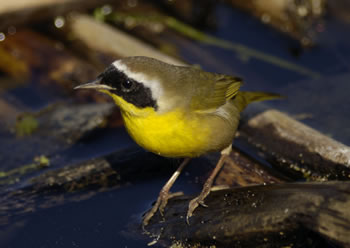YellowthroatThe morning was gloomy. Being in a dentist’s office in downtown Long Beach did not help matters. Little color – other than the fish swimming in the tanks meant to soothe patients’ frayed nerves.
Idly, I glanced out the window, perhaps drawn by some small motion. The busy street was only partially masked by a small tree and a few low shrubs. Then a bird popped into the open, pausing on a branch. A yellowthroat!
As the right side of my brain gloried in this little guy’s gorgeous nature, my left side’s instant reaction was, “What’s that doing here?” For yellowthroats are creatures of marshlands, damp patches of reed and tall grasses, not birds to mix with hoi polloi of pigeons and house sparrows in urban cityscapes.
The books call this member of the warbler family of small insect-eating birds the Common Yellowthroat. While I admit this species is not short in numbers, there was nothing “common” about the brilliant yellow throat and white-bordered black face mask of the adult male I was seeing. Spectacular!

But warblers are nothing if not active birds, and with a leap my yellowthroat disappeared into the leaves above. For the next few minutes I would catch an occasional glimpse as the bird hunted through the vegetation for a bit to eat. Then, nothing. I did not see the yellowthroat go, but surely it had, continuing on from wherever it had come to wherever it might be headed.
Perhaps this was a migrant bird, though we have yellowthroats here all year round. Take a walk at the nearest marsh and you’ll be sure to hear (listen for the twanging rubber band!) if not see one. Sometimes seeing takes a bit of patience. However, it’s patience well rewarded.
I’ll never know if my Long Beach friend was resident or migrant, but at least a trip to the dentist will never be quite the same again!


